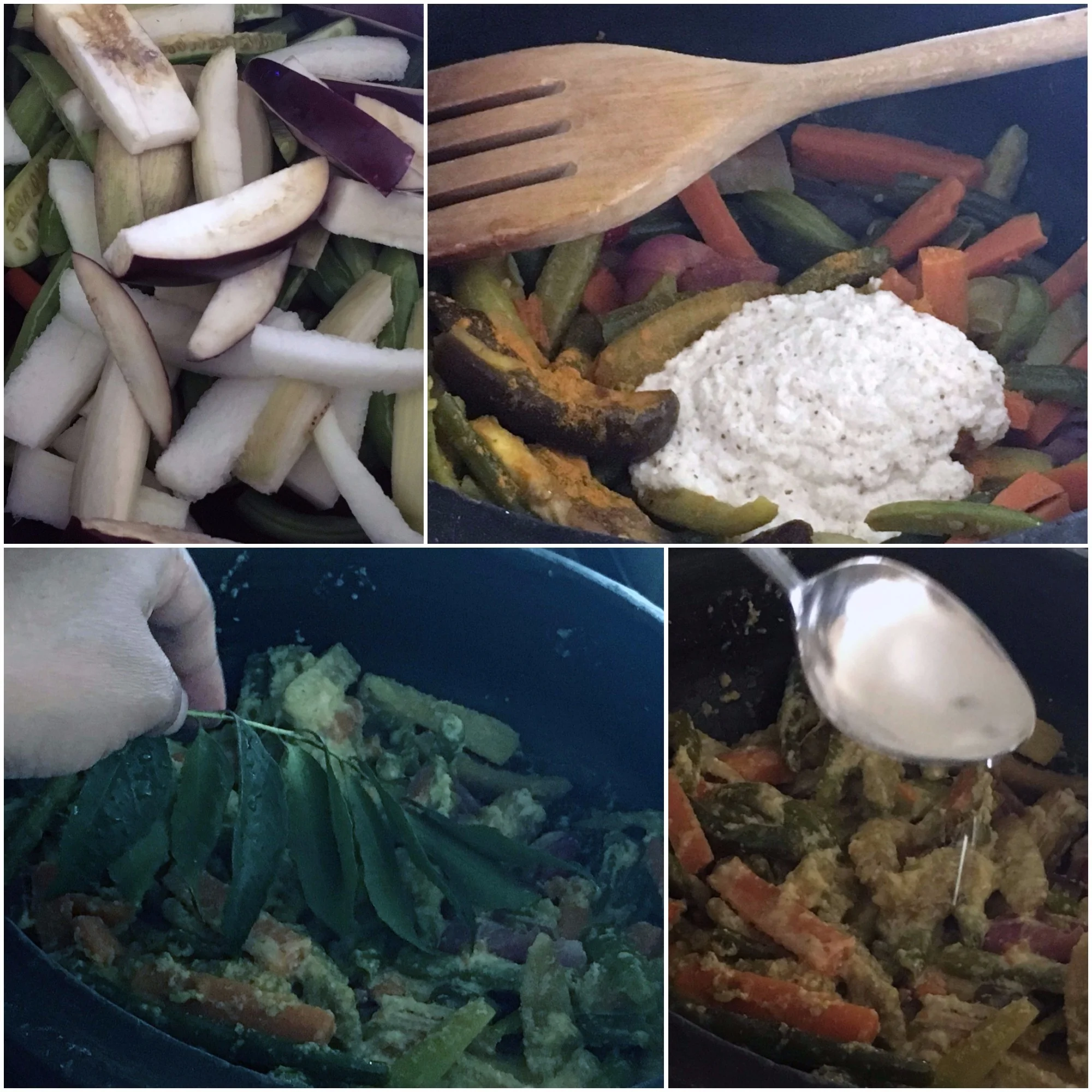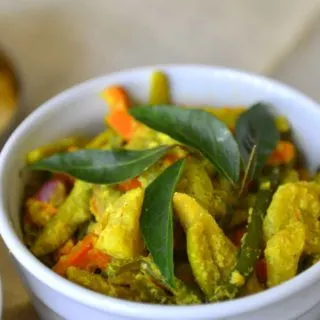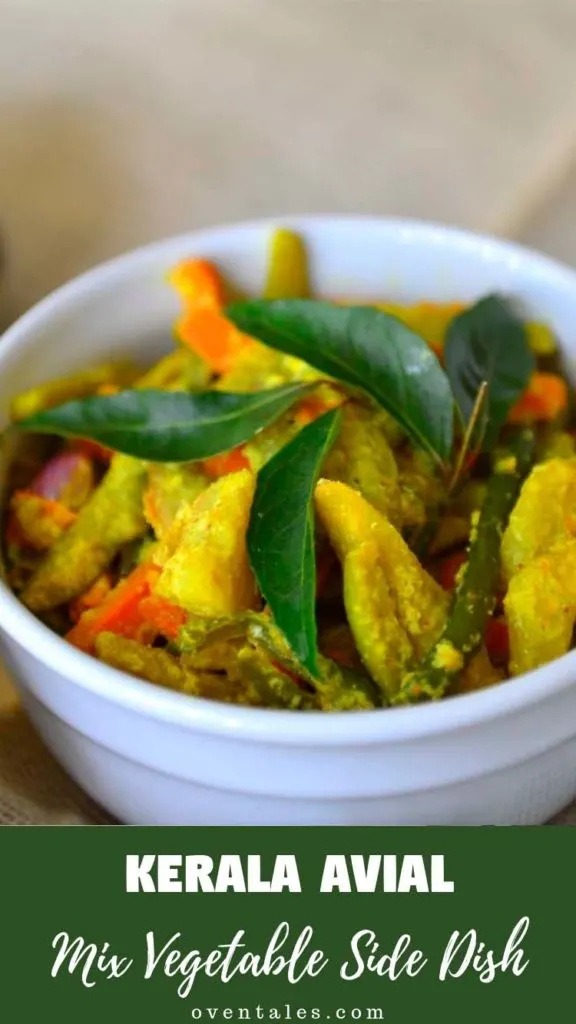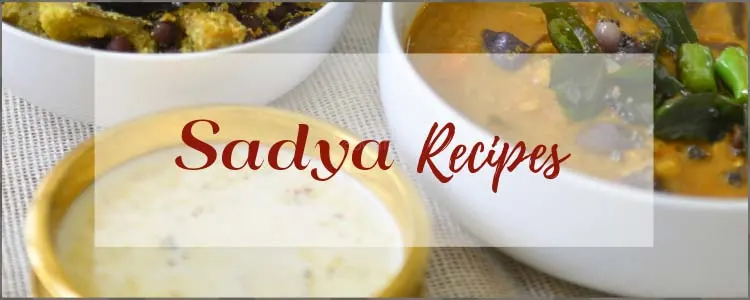How do I describe Avial? A mix of vegetables in a tangy coconut sauce ? This could describe a number of things. This is a dish popular in Kerala and neighboring regions. Different variations of this recipe exist in other parts of south India – those I would refer to as “vegetables with in mildly tangy coconut sauce”.

A perfect Kerala Avial is “a thing of beauty”. The vegetables are cooked just enough to hold its shape while still managing to flavor each other. These are lightly coated with fresh ground coconut mix. There is a bare minimum of spices used – cumin, green chilies , curry leaves and turmeric, but that is all it takes. It is not a dish overwhelmed by the coconut or spices, the star here is the vegetable mix.
There is no tadka or tempering , just a dash of extra virgin coconut oil at the end.
When raw mango is available, that is used as the sour agent , other times it is sour curd or tamarind. Whichever you prefer use only a little, just enough to round off the flavors. Of all these the raw mango is the wild card. It could turn more tangy as it cooks, or more sweet if it were close to ripening. Raw mango goes in with the vegetables, so once you add it there is no turning back. But Avial made with raw mango is one of the best. Sour curd and tamarind are, let me say, more “cook friendly”. You can add as much or as less as needed along with the coconut.
Search the web and you will find stories of origin of this dish. Many attributing to avial mythological connections. Bhima from Mahabharatha is reputed to be the creator of this dish. Whenever the kings and princes of these great stories are banished from their kingdom, they seem to end up in the South. Wonder why !!
But that is not the story that I have read, and was told in my childhood. This dish was the brainchild of a cook or his master who loathed waste. So the vegetable scraps leftover from the meal prep were thrown into a pot with a few seasonings and that is how this delicious concoction came to be.
This is a story that seems entirely plausible. There is a little of all popular Kerala vegetables that go into this dish, so much so that enterprising vendors used to sell the mix of leftover vegetables as “Avial Pieces” decades back. There is padavalnga (snake gourd), carrots, plantains or green bananas, beans like long beans or cluster beans, ash gourd, kovakka (ivy gourd), and list goes on. Some even add add not so popular vegetables like bitter gourd as well.
Whatever the origins are, Avial is an important part of Kerala feasts, whether it is OnaSadya or celebratory feast like birthdays or weddings. The way Malayali’s make it

If you are lucky to have the traditional Kerala vegetables use them, otherwise use the mix you have . Leafy vegatables, okra, and pretty much anything that turns slimy or into as mush as soon as cooked are not used. Cut the vegetables into pieces about 11/2 to 2 ” long (some prefer it longer) and about 1/2 cm tick . If you have vegetables with varying cooking times , either start those early or layer them at the bottom of the pan.
So let’s get on with recipe, eh !

Kerala Avial
Ingredients
Vegetables - See Notes
- 1 Raw banana Small
- 1 Carrots
- 1 Vellari Small piece
- 1 Elephant Yam Small piece
- Few Long beans
- 5 - 6 Jackfriuit Seeds
- 1 Brinjal / Small Egg plant
- 4 Inch Padavalanga / Snake Gourd
- 5 -6 Kovakka/ Ivy Gourd
- 2 -3 Drumstick
- 4 - 5 Pearl Onions optional
Sour Agents (Choose One)
- 1/2 C Raw Mango strips
- Tamarind - Marble sized ball
- 1/2 C Sour Curd
To Grind
- 1/2 Tsp Cumin Seeds
- 1 C Grated Coconut Lightly packed
Flavorings
- 2 - 3 Green Chilies To Taste
- 1/2 Tsp Turmeric
- 1/2 Tsp Salt To Taste
- A Few Curry Leaves
- 1 - 2 Tbsp Coconut oil
- 1/2 C Water
Instructions
- If using tamarind as sour agent soak it in 1/4 C warm water.
- Cut the drumstick into 3 " long pieces. Cut the remaining vegetables into 1/2 cm thick strips of around 2 inches in length.
- In a pot add the veggies one by one in layers, starting with the ones that need more time to cook first (See Notes). Add the chilies and a couple of curry leaves. Sprinkle salt and turmeric on top and slowly drizzle the water over. Place the lid on and cook over medium heat for 10 minutes.
- While the vegetables are cooking grind the coconut and cumin seeds into a coarse paste without adding water.
- Open the lid and check the vegetables. If he vegetables aren't cooked through, cook for a few minutes. Add the coconut paste replace the lid and cook on low heat for another 5 minutes. If using pearl onions, crush and add along with the coconut paste.
- Remove the lid and add enough tamarind water or curd for sourness and slowly turn the vegetables over so that the spices coat eat piece. .
- Taste and adjust salt as needed.
- Turn off the heat an drizzle the coconut oil on top. Place a few curry leaves on top and cover with the lid. Let the Avial rest at least 30 minutes to give the flavors a chance to mature.
Notes
- I have given a list of traditional vegetables, when not available use vegetable like - beans, carrots, potatoes, and cucumbers in equal quantity.
- If using mango as the sour agent, add it as the top layer along with the vegetables, so it can be removed easily if it turns too tart while cooking.
- Onions, if using, are not added with the vegetables. Add them along
with the coconut paste. - If there are vegetables very different cook times , pre cook the ones
with longer cook times before adding the rest.
Important: Nutrition Values are estimates. Actuals vary based on ingredients and serving size.
Is there any wonder I called this a vegetarian’s delight ? There are over 10 different vegetables in a traditional recipe. If you are not in Kerala, chances are all these vegetables aren’t in your kitchen. Use the one you have , I have made Avial with only carrots, beans, cucumber and potatoes. Though the aficionados may thump their noses at this – a handful of vegetables is better than nothing :-).
The traditional vessel for cooking Avial is a Manchatti or Kalchatti – an unglazed earthernware or stoneware pot. These hold heat more than the metal pans and dish tends to cook a little more as it rests. If you own one of these use it to make Avial.

LOOKING FOR MORE SADYA RECIPES ?

